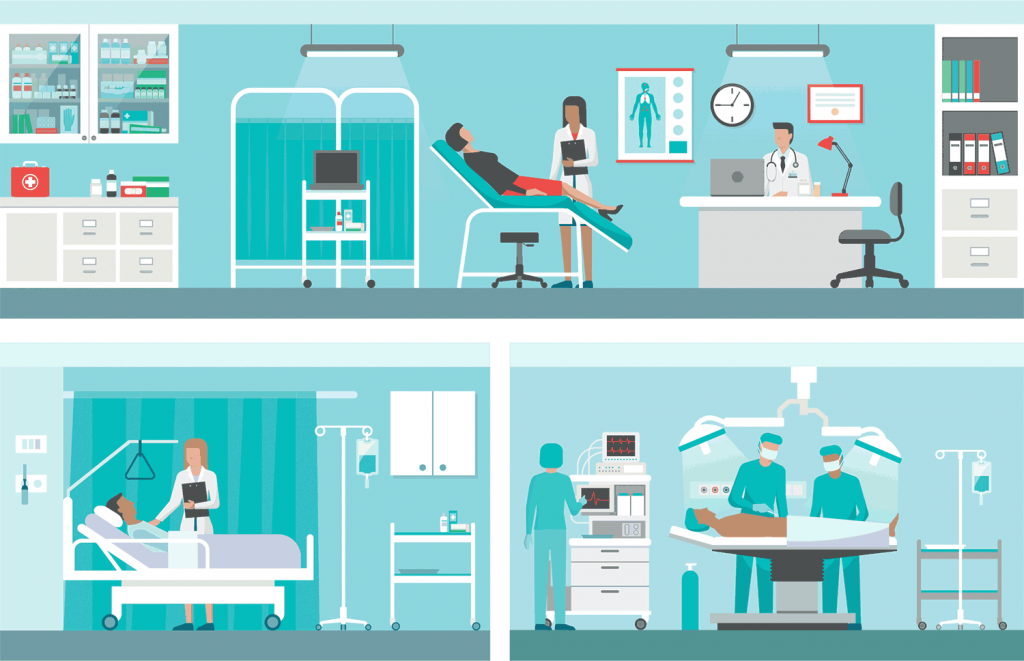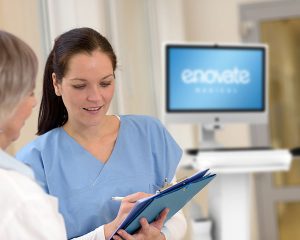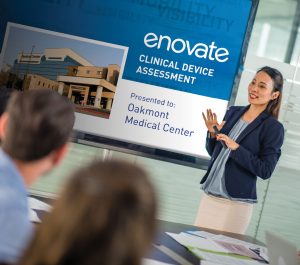
What Is a Clinical Device Assessment?
If you’re looking for ways to improve the work life of your nurses, consider addressing the demands and distractions created by the IT hardware used for bedside charting. The Electronic Health Record (EHR) is here to stay. Reverting to paper charting is not a reality nor should it be. However, finding the right hardware that will integrate seamlessly into your existing clinical workflows, even when considering the uniqueness of multiple clinical specialties, may be much easier than you think.
Enovate Medical has a solution for your dilemma – a Clinical Device Assessment. A Clinical Device Assessment offers a department-specific workflow analysis of workstation needs, supporting informed decision making. You must diagnose before you prescribe, and one workstation configuration does not fit all.
Overcoming Workflow Challenges with a Clinical Device Assessment

A clinical workflow has many variables. The clinical specialty, the medication distribution model, and the room and floor layout all create slightly different workflow requirements. Different workflows often require multiple workstations: fixed and mobile workstations featuring numerous configurations within each.
With a team that has the experience of hundreds of EHR go-lives, rollouts, and refreshes, Enovate Medical provides a complementary service to help get it right from day one. Finding the optimal computing device as the EHR portal for charting in the presence of the patient requires considering many available options. These include a laptop on a rolling stand, a handheld phone or tablet, a full-size display and keyboard/mouse mounted on the wall by the bedside, and a workstation on wheels with a work surface, a barcode scanner, and a specimen collection label printer.
After far too many experiences of clients going it alone and being limited to selecting devices from a catalogue, a demo day in the training room or cafeteria, or a device fair of a plethora of products in a line up, the Enovate team realized things needed to change. Promoting products before we even took the time to truly understand the needs often created more confusion than clarity. The medical community would never prescribe a medical or treatment plan without first accurately diagnosing the problem. So, why were we trying to prescribe a product before we had performed a walk-through of the various departments to understand the floor plans and layouts, room sizes, staffing levels and nurse-to-patient ratios?
[Relevant Reading: OneTouch Ticketing – Improve IT and Clinical Workflows with Ease]
Developing a Template for Success: The Clinical Device Assessment

To capture the knowledge of our team’s experience with so many hospitals across the country, Enovate formalized this walkthrough into a process called a Clinical Device Assessment (CDA). This resulted in a digital questionnaire and then a web-based application that could be used on mobile devices during the walk through. A clinical device assessment is a department-specific workflow analysis used to identify the best fit for workstation configurations.
Complete with pictures to reference, breakdowns per department, and configuration-specific hardware/device recommendations these inputs are transformed into a formal presentation. All too often, this highlights the overlooked opportunities to gain productivity and to improve the quality of work life for nurses, physicians, and the ancillary staff, like respiratory therapy, phlebotomy/lab, patient access, etc. Many times, hospital managers and directors can leverage the CDA outcome to lobby with senior leadership to appropriate the funding necessary to make improvements that will positively impact the patient experience and the quality of care.
How Does the CDA Work and Who From the Hospital Needs to Be Involved?
The local Enovate account executive (AE) works directly with a liaison on the IT support team to schedule the walk through. This IT project champion will accompany the Enovate AE as they visit each department at a hospital. The walkthrough lasts 2 to 3-hours at a single hospital of 200 or more beds and less time for smaller hospitals. Even with hospitals from 400 to 800 beds, the walkthrough can be completed in about the same time.
The process begins with a short huddle with the hospital IT liaison, and often the clinical informatics leader, to define goals and objectives for the day as well as create the visit schedule for each department. Within each department, the 3 members conducting the CDA (Enovate AE, hospital IT liaison, hospital CI Director) will take around 5 minutes to interview each department director to understand challenges, preferences, and desired outcomes.
Information gathered includes feedback on existing documentation solutions – tablets, desktops in the alcove between rooms, wall mounted computers in the room, and workstations on wheels. Additionally, the number of rooms, max staffing levels, ideal nurse to patient ratio, and medication delivery protocols will be identified. Feedback also is gathered from 2 to 3 clinical users to further understand where improvements are needed.
[Deployment Use Case: Mobile Technology Makes 5,000 Daily Vaccinations Possible for SCL Health in Colorado]
What Happens After the Walkthrough Is Complete?
One of the positive impacts of this process is that nursing staff feel appreciated from the CDA team taking the time to visit with them, listen to their challenges, and consider their feedback when making a purchase decision. Talking with the end users firsthand not only improves employee relations but gives the CDA team tremendous insight about what can be changed to realize better outcomes.
After leaving the hospital, the Enovate AE will take all the notes and pictures and organize them into a formal proposal. The proposal will include supporting evidence to validate the documentation devices and configurations recommended, department by department. Complete with direct feedback from nursing directors as well as clinical end users, this data will also be rolled up into a hospital wide implementation plan. The plan will include device/configuration counts, available installation/deployment services, maintenance and lifecycle maintenance plans, and budgetary numbers for either a capital or operational purchase or managed services subscription plan.
Enovate’s Clincial Device Assessment: A step-by-step overview
 Step 1: The Walkthrough: What will be considered?
Step 1: The Walkthrough: What will be considered?
Hospital Current Practices
- Opportunities for improvement and nursing requirements
- Medical delivery protocols to the patient room
- Specialty applications like patient access and phlebotomy
Hospital Building Infrastructure
- Room centric (fixed) and nursing centric (mobile) options
- Locations for in-room solutions that fit nursing workflow
- Installation for in-room solutions to include data and electrical outlets
- Room size and floor plans that support navigation of mobile options
Staffing
- Acuity levels and corresponding nurse-to-patient ratios
- Min and max staffing levels as well as patient census variables
- Shared or dedicated devices for physician, nursing, and ancillary groups
Step 2: The Recommendations: How can we review the takeaways of the walkthrough?
- A formal presentation with configurations recommended by department
- Supporting evidence in the form of pictures and nursing feedback
- A roll up of the hospital-wide plan to include budgetary pricing
- Installation, integration, and deployment support options available
- Managed services available throughout the product life cycle
- Insights into how asset management software can optimize productivity
Step 3: The Outcome: Where to expect productivity gains
- Increased nursing satisfaction and productivity
- Increased device availability
- Efficient delivery of medications
- More time to focus on the patient
Why You Shouldn’t Skip the Clinical Device Assessment
No matter where you are in the buying cycle, a clinical device assessment can provide valuable insights into your clinical workflows. Enovate Medical developed the CDA to address an often-overlooked, yet mission critical element of clinical operations; finding the best fit when it comes to EHR documentation solutions. We’ll help you deteremine which solutions work seamlessly within the already established workflows.
Contact one of our team members to start your clinical device assessment today.


